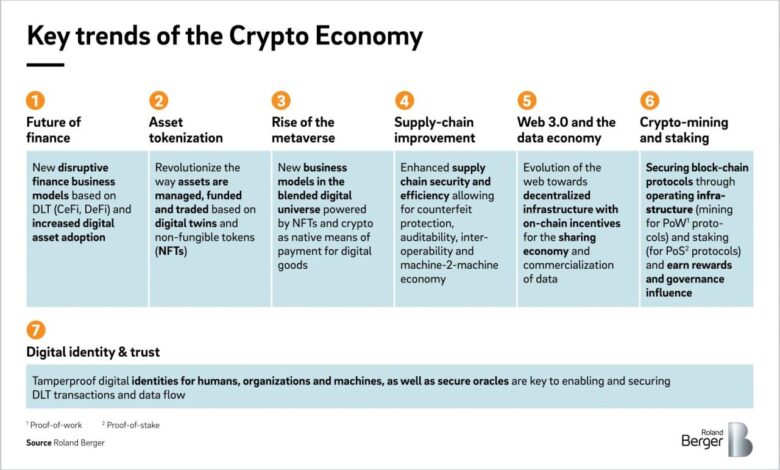
How Institutional Adoption Is Transforming the Crypto Market
How Institutional Adoption Is Transforming the Cryptocurrency Market Landscape is a dynamic and rapidly evolving phenomenon. Institutions like hedge funds, pension funds, and banks are increasingly entering the crypto space, driving significant changes to the market’s liquidity, volatility, and overall structure. This shift is reshaping investment strategies, prompting regulatory action, and leading to innovation in crypto products and services.
Understanding this transformation is crucial for anyone navigating the modern cryptocurrency landscape.
This exploration delves into the various facets of institutional investment in cryptocurrencies, from the growth and evolution of this trend to its impact on retail investors. We’ll examine the different investment strategies employed by institutions, the regulatory landscape, technological infrastructure, and the potential for future market growth. Get ready to uncover the profound impact institutions are having on the future of crypto.
Institutional Investment Trends
Institutional investment in cryptocurrencies has exploded in recent years, driven by the desire for diversification and potential high returns. This surge represents a significant shift in the market, transforming it from a predominantly retail-focused arena to one attracting major players with substantial capital and sophisticated strategies. This shift signals a growing legitimacy and acceptance of cryptocurrencies within the traditional financial world.The growth isn’t uniform across all institutional investors.
Some are early adopters, while others are cautiously observing the market. However, the overall trend is undeniably toward increased institutional participation, reflecting the evolving maturity and transparency of the cryptocurrency landscape.
Growth and Evolution of Institutional Investment
The early stages of institutional investment in cryptocurrencies were marked by cautious exploration and a focus on specific use cases. Hedge funds, often seen as the pioneering investors, initially sought to leverage cryptocurrencies for portfolio diversification and arbitrage opportunities. As the market matured, the involvement of other institutional players, including pension funds and banks, increased. This broader participation signifies a wider acceptance of cryptocurrencies as legitimate assets.
Types of Institutional Investors and Strategies
A diverse range of institutional investors are now participating in the cryptocurrency market. Hedge funds often employ sophisticated quantitative strategies, leveraging their expertise in market analysis and risk management to identify opportunities in volatile markets. Pension funds, seeking long-term growth for their beneficiaries, are increasingly looking at cryptocurrencies as a potential diversifier, albeit with greater caution than hedge funds.
Banks, with their established infrastructure and financial expertise, are beginning to explore institutional-grade cryptocurrency services, including custody and trading.
- Hedge Funds: Hedge funds often use sophisticated quantitative models and algorithmic trading to capitalize on short-term market fluctuations and arbitrage opportunities in the cryptocurrency market. They often utilize complex derivatives strategies and focus on risk management. For instance, some hedge funds have successfully employed quantitative models to identify and capitalize on arbitrage opportunities between different crypto exchanges.
- Pension Funds: Pension funds, prioritizing long-term growth and stability, are increasingly exploring cryptocurrencies as a diversifying asset. However, their involvement is often more cautious, with a focus on established and regulated platforms to mitigate risk. Their strategies typically involve allocating a small percentage of their portfolio to crypto, aligning with their long-term investment goals.
- Banks: Banks are exploring various avenues to incorporate cryptocurrencies into their services. Some are offering custodial services for institutional clients, while others are developing specialized trading desks focused on cryptocurrencies. Their strategies are influenced by regulatory frameworks and the need to balance risk and potential reward. For instance, some banks are creating institutional-grade platforms to facilitate crypto transactions for large clients, providing more secure and regulated access to the market.
Investment Vehicles
Institutional investors utilize a variety of investment vehicles to gain exposure to cryptocurrencies. These include direct investments in cryptocurrencies, exchange-traded funds (ETFs) that track crypto indices, and specialized crypto funds. Each vehicle carries its own set of risks and rewards, and the selection depends on the specific investment goals and risk tolerance of the institution.
- Direct Investments: Direct investments in cryptocurrencies allow institutions to gain direct exposure to the underlying asset. This involves purchasing cryptocurrencies on regulated exchanges or through brokerages specializing in institutional trading.
- Crypto ETFs: Exchange-traded funds (ETFs) that track crypto indices offer a more accessible and diversified way to gain exposure to the cryptocurrency market. They provide a structured and regulated way to invest in a basket of cryptocurrencies.
- Specialized Crypto Funds: Specialized crypto funds provide institutional investors with access to diversified portfolios managed by experienced crypto investment professionals. These funds often employ more complex strategies, allowing investors to benefit from specialized expertise in the space.
Comparison of Investment Strategies
The investment strategies of different institutional players vary significantly. Hedge funds often prioritize short-term gains and arbitrage opportunities, while pension funds emphasize long-term diversification and risk mitigation. Banks focus on developing robust infrastructure and services for institutional clients.
Institutional Investment Volume (Illustrative Table)
| Crypto Asset | 2020 (USD Millions) | 2021 (USD Millions) | 2022 (USD Millions) |
|---|---|---|---|
| Bitcoin | 500 | 5,000 | 3,000 |
| Ethereum | 200 | 2,500 | 1,500 |
| Other Altcoins | 100 | 1,000 | 500 |
Note: This table is illustrative and based on estimated figures. Actual figures may vary.
Institutional adoption is seriously reshaping the crypto market, with more companies and funds jumping in. This is significant, especially considering President Donald Trump says he’ll ‘demand that interest rates drop immediately’ President Donald Trump says he’ll ‘demand that interest rates drop immediately’. Such a move could impact investor confidence, potentially influencing institutional investment decisions in the cryptocurrency space.
Ultimately, however, institutional interest remains a powerful force propelling the continued growth and transformation of the cryptocurrency market.
Impact on Market Liquidity and Volatility: How Institutional Adoption Is Transforming The Cryptocurrency Market Landscape
Institutional adoption is reshaping the cryptocurrency market, bringing with it significant changes in liquidity, volatility, and overall market structure. Traditional financial institutions, hedge funds, and large corporations are increasingly entering the space, injecting substantial capital and altering the dynamics of trading. This influx of institutional capital brings both opportunities and challenges to the market.The impact of institutional investment extends beyond just price fluctuations.
Institutional investors pouring into crypto is significantly altering the market, driving demand for faster, cheaper transactions. Understanding Layer 2 solutions like state channels and sidechains is key to handling this increased volume efficiently. These solutions, detailed in Understanding Layer 2 Solutions for More Efficient Cryptocurrency Transactions , are becoming crucial for the continued growth of institutional adoption and the overall health of the crypto ecosystem.
This improved transaction efficiency is essential as institutional involvement continues to rise, paving the way for mainstream acceptance.
It fundamentally alters the supply and demand dynamics, potentially influencing the long-term trajectory of the market. Understanding these transformations is crucial for both existing and prospective investors.
Impact on Market Liquidity
Institutional investors, with their substantial trading volumes, are a critical component in improving market liquidity. Their ability to absorb large quantities of cryptocurrency during both bull and bear markets stabilizes price movements and reduces the risk of extreme price swings. By providing consistent buying and selling pressure, institutions create a more robust and reliable trading environment. This translates to better price discovery and greater confidence among market participants.
Influence of Institutional Buying and Selling on Price Volatility
Institutional buying and selling patterns can exert significant influence on price volatility. Large-scale purchases can drive prices upward, while significant sell-offs can lead to downward pressure. However, the presence of institutional investors often mitigates these effects. Their sophisticated trading strategies, coupled with their financial resources, allow them to navigate market fluctuations more effectively. This calculated approach, in contrast to the often-emotional reactions of individual traders, contributes to a more stable price environment.
Impact on Market Depth and Trading Activity
The entry of institutional investors deepens market depth. Market depth refers to the amount of buying and selling orders at different price levels. Institutions’ large order books provide a wider range of pricing options, making it easier for smaller traders to execute their trades at favorable rates. This increased market depth results in higher trading activity as more participants feel confident in the market’s stability.
Impact on Overall Cryptocurrency Market Structure, How Institutional Adoption Is Transforming the Cryptocurrency Market Landscape
Institutional adoption fundamentally alters the cryptocurrency market structure. The entrance of established financial players brings with it more sophisticated trading infrastructure, enhanced security measures, and greater regulatory scrutiny. This shift in structure leads to a more professionalized market, which, in turn, fosters greater trust and adoption among mainstream investors.
Comparison of Pre- and Post-Institutional Adoption Volatility (Example: Bitcoin)
| Characteristic | Pre-Institutional Adoption (2017-2020) | Post-Institutional Adoption (2021-Present) |
|---|---|---|
| Average Daily Price Volatility (%) | High (often exceeding 5%) | Moderately high, but with fewer extreme spikes (typically below 5%, but with occasional exceptions) |
| Number of Large Transactions | Low | High, with institutional investors driving significant trading volumes. |
| Market Depth | Shallow, limited trading options | Deep, providing a wide range of buying and selling opportunities. |
| Trading Activity | Fluctuating, often experiencing periods of inactivity | Consistent, high trading volume. |
Note: The data in the table is illustrative and not exhaustive. Volatility figures and specific transaction data can vary depending on the time frame considered and the specific market conditions.
Regulatory Landscape and Compliance
The burgeoning institutional interest in cryptocurrencies necessitates a robust and adaptable regulatory framework. Without clear guidelines and consistent enforcement, the potential for market manipulation, fraud, and illicit activities increases significantly. This regulatory environment needs to balance fostering innovation with protecting investors and maintaining market integrity. The diverse approaches adopted globally highlight the challenges in creating a universally accepted regulatory structure.The regulatory landscape surrounding institutional cryptocurrency investment is complex and evolving rapidly.
Jurisdictions are grappling with how to categorize cryptocurrencies, regulate exchanges, and establish compliance requirements for institutional investors. This evolving nature necessitates a flexible and forward-thinking approach from regulators and industry participants alike. The goal is to foster a safe and transparent environment that encourages investment while mitigating risks.
Overview of Global Regulatory Approaches
Various jurisdictions are taking different approaches to regulating institutional cryptocurrency investments. Some countries are embracing a more permissive approach, allowing for innovation while imposing robust compliance requirements. Others are adopting a more cautious stance, imposing stringent regulations to limit potential risks. This diversity creates a complex and multifaceted regulatory environment for institutional investors.
Regulatory Challenges Faced by Institutional Investors
Institutional investors face significant challenges navigating the current regulatory environment. Lack of clarity in regulations across different jurisdictions can lead to compliance complexities. Determining the appropriate regulatory framework for a specific investment strategy can be a significant hurdle. Ensuring compliance with varying regulatory requirements in different markets where investments are made can also be challenging. Furthermore, the dynamic nature of the crypto market and the ever-evolving regulatory landscape demand constant vigilance and adaptation from institutional investors.
Role of Regulatory Bodies in Shaping Institutional Adoption
Regulatory bodies play a crucial role in shaping institutional adoption of cryptocurrencies. Clear and consistent regulations provide institutional investors with the necessary confidence to participate in the market. By establishing robust regulatory frameworks, regulatory bodies can foster trust and transparency, thus encouraging wider adoption. Conversely, unclear or overly restrictive regulations can deter institutional investment, hindering market growth.
Compliance Requirements and Standards
Compliance requirements for institutional cryptocurrency investment vary significantly based on jurisdiction. Key aspects include KYC/AML (Know Your Customer/Anti-Money Laundering) procedures, reporting requirements, and security protocols. These requirements aim to prevent illicit activities and ensure the integrity of the market. Investors must adhere to these rules to avoid legal ramifications and maintain operational compliance.
Table: Varying Regulatory Approaches Across Jurisdictions
| Jurisdiction | Regulatory Approach | Key Characteristics |
|---|---|---|
| United States | Fragmentation | Different regulatory bodies oversee different aspects of the crypto market. This results in a complex and sometimes contradictory approach. |
| European Union | Harmonization Efforts | The EU is working towards harmonizing regulations across member states. This aims to create a more consistent and predictable environment for investors. |
| United Kingdom | Progressive Approach | The UK has taken a more progressive approach, aiming to balance innovation with regulatory oversight. |
| Singapore | Pro-Innovation | Singapore is known for its pro-innovation stance towards cryptocurrencies. |
| China | Suppressive | China has implemented strict regulations and restrictions on cryptocurrency trading and mining. |
Technological Infrastructure and Security

Source: kryptowheel.com
Institutional adoption of cryptocurrencies necessitates robust technological infrastructure and robust security measures. The shift from retail to institutional investment demands platforms capable of handling high volumes of transactions, sophisticated risk management tools, and regulatory compliance. This transition necessitates significant advancements in technology and security protocols to ensure the safety and reliability of institutional cryptocurrency holdings.
Technological Advancements Enabling Institutional-Grade Cryptocurrency Investment
Modern blockchain technology and related innovations provide the foundation for institutional-grade crypto investment. Smart contracts automate trades, reducing the need for intermediaries and enhancing efficiency. Decentralized finance (DeFi) protocols offer automated lending, borrowing, and trading capabilities, further streamlining institutional investment processes. High-performance computing and specialized algorithms facilitate complex portfolio management and risk analysis, essential for large-scale institutional investments.
Security Protocols and Measures Implemented by Institutions for Crypto Asset Management
Institutional investors prioritize security above all else. Multi-signature wallets, requiring multiple authorized parties for transactions, are a common security measure. Cold storage, offline wallets that safeguard assets from online threats, are crucial for long-term preservation. Advanced encryption techniques, such as those using elliptic curve cryptography (ECC), protect data and transactions from unauthorized access. Robust auditing procedures, including independent audits of the security infrastructure, are implemented to ensure compliance and transparency.
Infrastructure Required for Secure and Reliable Institutional Cryptocurrency Transactions
A robust infrastructure is essential for smooth and secure institutional transactions. High-speed and reliable connectivity is paramount for timely execution. Scalable platforms are required to handle high transaction volumes without compromising security or speed. Real-time monitoring systems, tracking asset movement and potential risks, are vital for operational efficiency and risk mitigation. Compliance with regulatory frameworks is critical, requiring infrastructure to support KYC (Know Your Customer) and AML (Anti-Money Laundering) requirements.
Key Players in the Development of Institutional-Grade Crypto Infrastructure
Several key players are driving the development of institutional-grade crypto infrastructure. Major exchanges are implementing institutional trading platforms and custody solutions. Specialized crypto custody providers offer secure storage and management services. Fintech companies are developing cutting-edge solutions for institutional investment. These players work together to meet the increasing demands of institutional investors.
Comparison of Cryptocurrency Custody Solutions for Institutional Investors
| Custody Solution | Security Features | Scalability | Compliance |
|---|---|---|---|
| Custodial Wallets (e.g., Coinbase Custody) | Strong security protocols, insurance backed, regulatory compliance | High scalability to handle large volumes | Excellent KYC/AML support, regulatory compliant |
| Cold Storage Solutions | Offline storage, reducing cyber risk | Scalability depends on the storage setup | Compliance depends on the specific solution |
| Multi-signature Wallets | Enhanced security through multi-party authorization | Scalability depends on the transaction volume | Compliance needs to be tailored to the use case |
| Decentralized Custody Solutions (e.g., certain DeFi platforms) | No single point of failure, but potential security risks from smart contracts | Scalability depends on the protocol | Compliance can be challenging depending on jurisdiction |
Note: This table provides a general comparison and individual solutions may vary in their specific features. Further research into particular custody solutions is encouraged for detailed information.
Market Capitalization and Asset Allocation
Institutional adoption is significantly reshaping the cryptocurrency market landscape. This influence extends beyond simple trading volume; it fundamentally alters the market capitalization of crypto assets and how investment capital is distributed across various coins and projects. The influx of institutional money brings with it a level of sophistication and long-term investment strategies previously absent in the market.The overall market capitalization of crypto assets is directly impacted by institutional investment.
As large institutions allocate capital, the perceived value and market share of different cryptocurrencies change. This phenomenon can be observed in the fluctuating market valuations, with some cryptocurrencies experiencing substantial price increases and others experiencing relative stagnation. This influence is not merely a short-term trend; rather, it suggests a long-term shift in how capital is allocated within the digital asset space.
Overview of Market Capitalization
The total market capitalization of cryptocurrencies is influenced by the buying and selling activity of institutional investors. Large-scale purchases can push prices upward, leading to a significant increase in the overall market capitalization. Conversely, institutional selling can trigger a downturn, potentially causing a substantial reduction in the total market value. This dynamic interplay underscores the growing importance of institutional players in shaping the market’s overall health and direction.
Allocation of Institutional Investments
Institutional investors aren’t simply pouring money into the market indiscriminately. They tend to prioritize specific cryptocurrencies and asset classes based on their perceived potential returns and risk profiles. For example, some institutions might favor established blockchains with robust ecosystems and active developer communities, while others might target newer, potentially disruptive technologies. This targeted approach is critical to understanding how institutional investment is reshaping the market.
Potential for Market Growth
The increasing participation of institutional investors suggests a substantial potential for future market growth. Their long-term investment strategies, coupled with their access to significant capital, can fuel innovation and development within the cryptocurrency sector. This investment can support the growth of infrastructure, development of new use cases, and increased adoption by the broader public.
Long-Term Implications
The long-term implications of institutional investment on the cryptocurrency market structure are profound. It introduces a degree of stability and predictability that was previously lacking. The increased liquidity provided by institutional investment can lead to more stable price movements, potentially reducing the volatility often associated with the cryptocurrency market. This is crucial for attracting further investment and fostering wider adoption.
Distribution of Institutional Investment
The table below illustrates a potential distribution of institutional investment across various cryptocurrency asset classes. Note that this is a hypothetical representation and actual allocations may vary significantly depending on individual institutional strategies.
| Asset Class | Percentage of Institutional Investment |
|---|---|
| Proof-of-Work Blockchains (e.g., Bitcoin, Ethereum) | 35% |
| Proof-of-Stake Blockchains (e.g., Solana, Polkadot) | 25% |
| Decentralized Finance (DeFi) Protocols | 20% |
| Non-Fungible Tokens (NFTs) | 15% |
| Other Emerging Crypto Assets | 5% |
Innovation and Product Development
The cryptocurrency market is rapidly evolving, driven by institutional investment. This surge in institutional interest is fueling innovation in crypto products and services, leading to more sophisticated investment tools and a wider range of opportunities for institutional investors. Specialized platforms and tailored solutions are emerging to meet the specific needs of large-scale investors, marking a significant shift in the market landscape.This innovative push is not just limited to new investment products; it also encompasses improvements in security, compliance, and regulatory frameworks.
The demands of institutional investors are pushing developers to create solutions that address the unique challenges of handling large sums of cryptocurrency, including enhanced security protocols and stringent regulatory compliance. This focus on institutional needs is transforming the entire ecosystem.
Innovation in Crypto Products and Services for Institutional Investors
Institutional investors require specialized investment tools and platforms tailored to their needs. These tools often include advanced analytics, portfolio management capabilities, and regulatory compliance features. This specialized approach is distinct from the retail-focused products commonly seen in the market. For example, institutional-grade crypto custody solutions are being developed with enhanced security protocols and robust audit trails to manage the high-value assets.
Development of Specialized Investment Tools and Platforms
The demand for sophisticated investment tools has spurred the creation of platforms designed for institutional investors. These platforms typically offer features like automated trading, advanced portfolio analytics, and secure custody solutions. They also provide streamlined regulatory compliance mechanisms to facilitate navigating the complex regulatory landscape. Furthermore, the rise of decentralized finance (DeFi) protocols has led to the development of specialized DeFi investment strategies for institutional investors.
These are more sophisticated than typical retail-focused options, with increased complexity and risk profiles.
Institutional adoption is rapidly reshaping the crypto market, bringing in serious capital and potentially altering trading patterns. But to truly capitalize on this shift, understanding the underlying market psychology is crucial. For instance, how do investor sentiments influence price fluctuations? Knowing this, alongside the intricacies of institutional investment strategies, can be key to navigating the crypto landscape effectively.
This understanding, detailed in Understanding Market Psychology to Make Better Cryptocurrency Investment Choices , is essential for any serious crypto investor looking to capitalize on the evolving institutional environment. Ultimately, this blend of institutional involvement and savvy market psychology is shaping the future of the crypto market.
Institutional Investment Driving New Crypto Products
Institutional investment is directly driving the development of new crypto products and services. As institutional investors demand specific functionalities, such as automated trading, advanced analytics, and tailored compliance solutions, developers are responding by creating specialized tools. The need for institutional-grade security and compliance is also prompting innovations in blockchain technology, leading to the creation of more secure and transparent platforms.
For example, some platforms are incorporating multi-factor authentication and advanced audit trails to meet the high security standards demanded by institutional investors.
Innovations in Security, Compliance, and Regulatory Frameworks
The entry of institutional investors necessitates innovations in security, compliance, and regulatory frameworks. Security protocols are becoming more sophisticated, incorporating multi-factor authentication, enhanced encryption, and secure cold storage solutions to protect large amounts of cryptocurrency. Compliance with regulations is paramount, leading to the development of specialized compliance tools and expertise to navigate the often-complex regulatory landscapes. Regulatory frameworks are evolving to adapt to the emergence of institutional players, and some jurisdictions are developing tailored regulations to accommodate the unique needs of crypto asset management.
Table of New Crypto Investment Products and Services for Institutional Investors
| Product/Service | Unique Features |
|---|---|
| Institutional-grade crypto custody solutions | Enhanced security protocols, robust audit trails, multi-factor authentication, and specialized cold storage |
| Automated trading platforms for crypto assets | Advanced algorithms, high-frequency trading capabilities, and integration with existing portfolio management systems |
| Specialized DeFi investment strategies | Tailored strategies for yield farming, lending, and borrowing, leveraging DeFi protocols, with comprehensive risk assessments |
| Crypto-focused hedge funds and investment vehicles | Diversified portfolios, sophisticated risk management strategies, and expert management teams specializing in crypto assets |
| Crypto-backed exchange-traded products (ETPs) | Liquidity enhancement, regulatory compliance, and access to crypto assets for institutional investors via traditional financial markets |
Impact on Retail Investors
Institutional adoption is rapidly reshaping the cryptocurrency market, and retail investors are caught in the crosscurrents. This shift brings both exciting opportunities and potential pitfalls. Understanding how institutional players are influencing the market is crucial for retail investors to navigate the evolving landscape effectively.The influx of institutional capital has a significant impact on market liquidity and volatility, affecting the accessibility and pricing of cryptocurrencies for retail investors.
This, in turn, influences the strategies and choices available to retail investors. Transparency and clear communication regarding institutional activities are essential for retail investors to make informed decisions.
Retail Investor Access to Crypto Markets
Institutional adoption often leads to increased market liquidity, making it easier for retail investors to buy and sell cryptocurrencies. Large-scale institutional purchases can, however, also drive up prices, making it more expensive for retail investors to enter the market. Furthermore, institutional investment often favors larger, more established cryptocurrencies, potentially limiting access to smaller, emerging projects.
Potential Opportunities for Retail Investors
Institutional involvement can create opportunities for retail investors. Increased liquidity and wider adoption can lead to more stable and predictable market conditions. Moreover, institutional demand can drive up the value of certain cryptocurrencies, creating potential for profit for retail investors who have timed their entry. Finally, the emergence of institutional-grade crypto products can offer more sophisticated investment options to retail investors, including exchange-traded funds (ETFs) and other regulated products.
Potential Challenges for Retail Investors
The increased influence of institutions can also present challenges for retail investors. Fluctuations in institutional investment strategies can lead to market volatility, potentially impacting retail investors’ holdings. Moreover, the concentration of institutional investment in specific cryptocurrencies can limit the range of investment options available to retail investors. Lastly, increased competition from institutional investors may push out smaller retail investors due to price discrepancies.
Influence on Retail Investment Strategies
Institutional participation influences retail investment strategies in several ways. The rise of institutional investment often prompts retail investors to consider larger, more established cryptocurrencies, potentially neglecting emerging projects. Retail investors may also adapt their investment strategies to align with institutional investment trends. For example, the success of a cryptocurrency fund managed by an institution may prompt retail investors to consider similar investments.
Transparency and Information Accessibility
Transparency regarding institutional activities is crucial for retail investors. Greater transparency regarding institutional holdings and investment strategies can help retail investors understand market trends and make informed decisions. Clear and accessible information about institutional investment activities, including disclosure of transactions and positions, is vital to maintaining a fair and efficient market.
Table: Impact of Institutional Adoption on Retail Investor Access
| Cryptocurrency | Impact on Retail Investor Access (Increased/Decreased/Neutral) | Explanation |
|---|---|---|
| Established Cryptocurrencies (e.g., Bitcoin, Ethereum) | Increased | Higher liquidity, wider adoption, potentially higher prices. |
| Emerging Cryptocurrencies | Decreased | Lower liquidity, potentially lower market visibility. |
| Cryptocurrencies with Institutional Backing | Increased | Potentially higher visibility, increased liquidity. |
End of Discussion

Source: rolandberger.com
In conclusion, institutional adoption is undeniably reshaping the cryptocurrency market. The influx of institutional capital is boosting liquidity, prompting innovation, and pushing the boundaries of the industry. However, this transformation also presents challenges, particularly regarding regulation and the potential impact on retail investors. Navigating this evolving landscape requires a deep understanding of the various forces at play, from investment strategies to regulatory frameworks.
As institutions continue to integrate crypto into their portfolios, the market will undoubtedly undergo further transformations, shaping the future of digital assets.
Q&A
What are the primary concerns regarding institutional adoption for retail investors?
Concerns often revolve around potential market manipulation, increased volatility, and shifts in access to certain cryptocurrencies. While institutional investment generally fosters market growth, the rapid pace of adoption can sometimes leave retail investors feeling caught off guard.
How are regulatory bodies responding to the rise of institutional crypto investment?
Different jurisdictions are implementing varying regulations to address the unique challenges and opportunities presented by institutional crypto investment. This includes establishing clear guidelines for compliance, security, and transparency.
What role do security protocols play in institutional cryptocurrency investment?
Robust security protocols are essential for institutional investors due to the significant value and sensitivity of their holdings. These protocols often involve multi-layered security measures, cold storage, and advanced encryption to mitigate risks.
How does institutional investment influence the development of new crypto products?
The demand from institutional investors often drives the development of sophisticated crypto products and services tailored to meet their specific needs, including more secure custody solutions, specialized investment tools, and compliant trading platforms.






